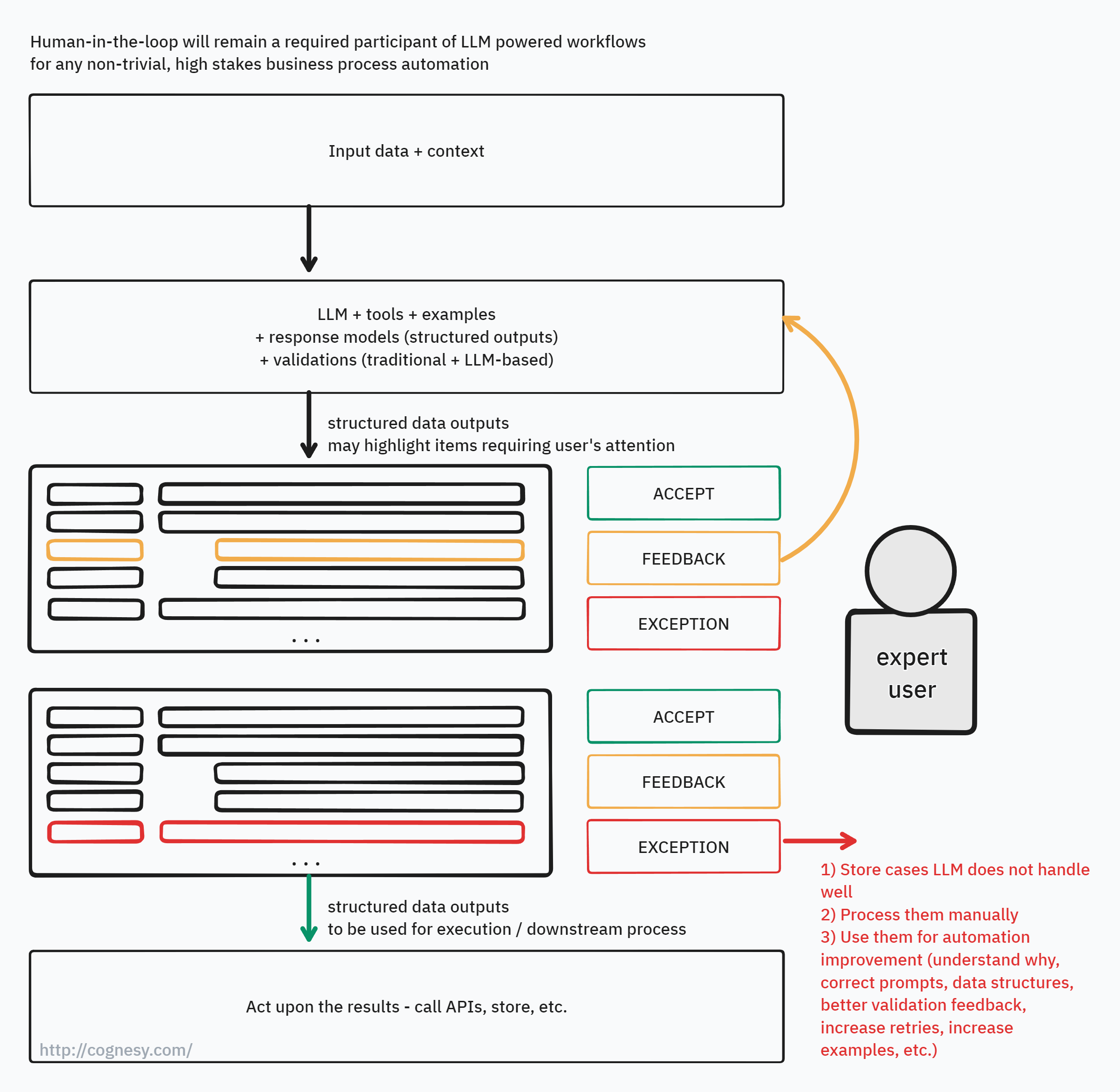
AI and Future of Work
- Cognesy Team
- Analysis
- September 8, 2024
As AI and large language models (LLMs) become more integrated into business workflows, the roles of knowledge workers will shift. Rather than being replaced, human contributions will become even more critical, and new opportunities will arise to increase the value of their work through enhanced collaboration with AI. This transformation will be driven by new incentives and user experience (UX) designs that focus on maximizing cooperation between humans and AI systems.
Human Roles in LLM-Powered Workflows
With the adoption of LLM-powered workflows, many routine tasks can be efficiently handled by AI agents. However, contrary to the belief that automation might eliminate human roles, the reality is that human involvement will evolve. Tasks previously completed manually will now be partially automated, with AI handling more repetitive or data-heavy aspects. This will enable humans to focus on higher-value activities like decision-making, strategy, and innovation.
While AI agents might take over some operations, key actions will still require human review, feedback, and approval. This hybrid workflow maximizes productivity while maintaining the human touch for crucial judgment-based activities. In this new landscape, workers won’t just process tasks—they will assume roles as instructors, managers, and conductors of individual AI agents or swarms of agents. Essentially, humans will act as orchestrators, ensuring that AI outputs align with company goals and quality standards.

The Potential for Multiplying Employee Output
This new dynamic presents an exciting opportunity: it has the potential to significantly multiply employee productivity. By overseeing and guiding AI systems, employees will deliver higher-quality outputs in less time. AI can perform multiple tasks simultaneously or handle complex data sets, leaving employees to make critical decisions or provide creative inputs. In this scenario, the value of an employee isn’t simply tied to how much work they can complete themselves but to how effectively they can direct and enhance AI performance.
AI systems, by nature, learn and improve over time. Human input will provide the high-value data needed to refine these AI models, improving their performance. Employees’ judgment, domain expertise, and feedback will be invaluable in training AI systems to become more accurate, relevant, and effective over time. This ongoing feedback loop will create a growing repository of intellectual property (IP) for companies, where human decisions are encoded into the AI’s decision-making framework.
Why Human Judgment Will Remain Essential
Even with advanced AI, human judgment remains irreplaceable. AI systems can analyze large amounts of data and generate insights, but they lack the contextual understanding, ethical consideration, and creative thinking that humans provide. For example, when AI systems generate recommendations or options, it’s the human operators who will assess whether those options align with company values, objectives, and strategic goals.
Additionally, AI may excel in automation and process optimization, but the quality and pace of that automation are ultimately shaped by human feedback. Employees will not only supervise AI but also ensure it learns from real-world complexities and edge cases. This feedback will help AI systems handle more nuanced tasks over time.
The Need for Human-Centric UX Design
To fully capitalize on AI-human collaboration, companies will need to rethink the UX of their systems. The goal will be to design workflows that allow humans and AI to interact seamlessly. User interfaces will need to focus on making it easier for employees to provide input, manage AI-generated suggestions, and evaluate AI-driven outcomes. As AI capabilities expand, workers will need more intuitive tools to monitor, adjust, and steer AI agents effectively.
One example is creating dashboards that give users visibility into what AI agents are doing, why they are making certain decisions, and how they can be adjusted. Providing easy ways to give feedback, refine AI behavior, or escalate decisions to human review will be essential in maintaining trust in AI-driven processes.
Incentivizing AI-Human Collaboration
As companies invest in AI, they must also consider how to incentivize their employees to participate in AI system development and improvement. Simply automating tasks without considering how humans can add value will not yield the best outcomes. Instead, companies should incentivize workers to contribute to the continuous improvement of AI systems.
This could involve recognizing employees who provide insightful feedback that leads to better AI performance or rewarding those who help AI systems solve complex problems. Another approach is to tie employee incentives to the success of AI-human collaboration. For example, workers could be measured not only by their direct output but also by the productivity gains achieved through AI collaboration.
Moreover, companies should prioritize upskilling their employees so that they are well-versed in managing and collaborating with AI. This requires an investment in training and education, ensuring that employees understand how AI functions, how to control it, and how to maximize its potential in their daily tasks.
Long-Term Value Creation Through AI “Disciples”
In the long term, a company’s AI systems will become its “disciples”—machines that have been trained, guided, and refined by the human experts who work with them. The collective knowledge and decision-making patterns of employees will be embedded in these AI systems, creating a long-lasting source of competitive advantage.
Companies that recognize this will foster a culture where humans and AI collaborate closely to continually improve. They will see AI not as a replacement but as a valuable partner that amplifies human strengths, ultimately leading to more innovative solutions, faster problem-solving, and better business outcomes.
The future of work will be defined by collaboration between humans and AI. As AI takes over more operational tasks, humans will transition into roles that focus on guiding, refining, and enhancing AI performance. By designing systems that facilitate this collaboration and incentivizing employees to contribute to the improvement of AI, companies will unlock new levels of productivity and long-term value.


